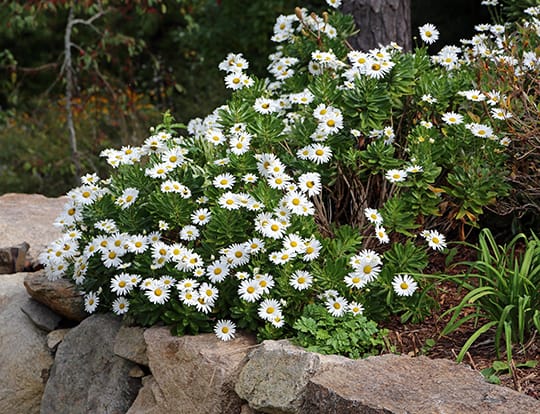I title this post intentionally because one of the most common questions I hear is about this fall-flowering perennial. “How do I keep my Montauk daisies from falling over?” or “When do I cut my Montauk daisies back so that they don’t fall over?”
Montauk daisies, aka Nippon daisies or Nipponanthemum nipponicum, are a favorite in my area because they are one of the last perennials to flower. If you live in zones 5 to 9 and have a sunny spot, you need this plant in your garden. Just know that this perennial needs to be treated like a shrub.
The leaves on Montauk daisies are heavy. As the stems lengthen, the numerous, heavy leaves cause the stalks to bend down. At the same time the natural way this plant grows is to let the lower leaves shrivel and brown while keeping the outer foliage green. So those who grow this plant see withering inner leaves and bare lower stems.
If the plant is generally upright and full, those inside stalks and withered foliage aren’t very visible. But if the plant is leaning over, the gardener focuses on that less-than-attractive inner plant.
Here are some tips for growing upright, full looking Montauk daisies:
- Grow these plants in at least 6 hours of dead-on sun. The more shade these plants are raised in, the more likely they are to fall over.
- Keep them on a lean diet. Fertilizer helps plants grow bigger and faster but it does not make stems stronger. The richer the soil, the more likely Nippon daisies are to flop. Similarly, don’t water these perennials frequently. A deep soaking every 7 to 10 days is perfect.
- The older the stems are the stronger they get. Don’t cut any upright stalks down. Prune off any stems that are horizontal, or parallel to the ground, but leave those that are more upright in place.
- Think of this plant as a small shrub, not a perennial. In other words, never cut it down to the ground. Leave it alone all fall and winter. In the spring cut off any dead wood or dieback, but leave any stalks that are alive and well in place. The older these stems get, the stronger they become.
- If you want you can shear these plants back by 3 to 6 inches in May or early June. This is most effective if your plants are already upright and strong…so focus first on tips 1 through 4 before thinking about pinching these perennials back in early summer.

Some flopping and spawling is expected with this wonderful perennial. Yes, the inner stems will be bare and the leaves inside will be shriveled. But this is easily ignored when you have daisies in late-September and October! This photo was taken in mid-October on Cape Cod. We'll have this cheerful plant in bloom into late October.

